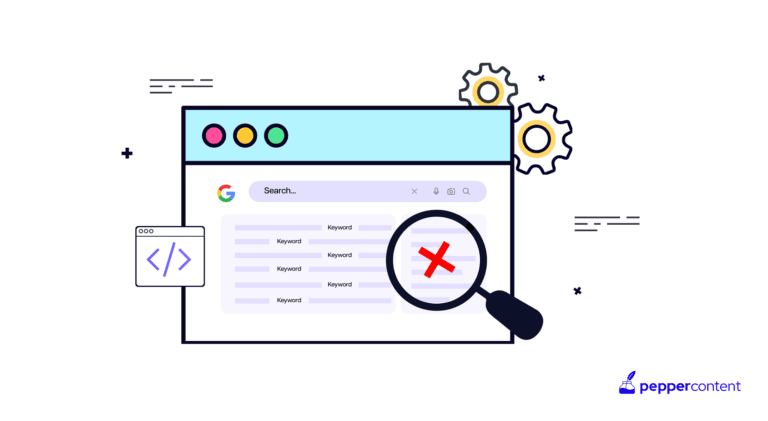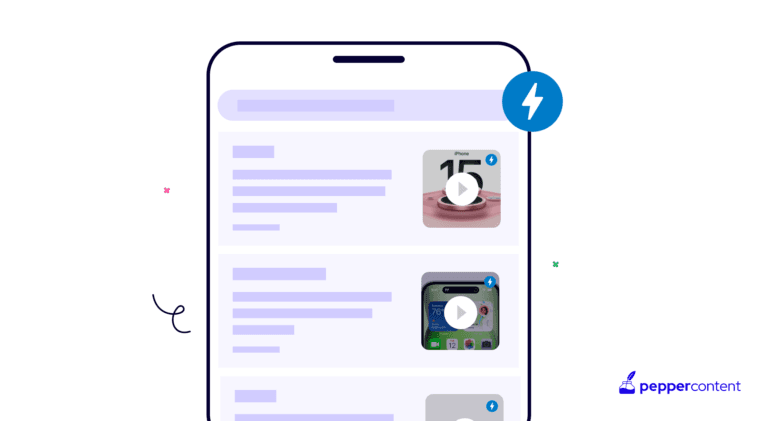Programmatic SEO and its Role in Improving Organic Traffic

With every passing year, it becomes increasingly crucial for brands to establish a robust online presence. And SEO accounts for the most significant part of website traffic and revenue. It helps to spread brand awareness, maximize traffic, and generate high-quality leads.
Many leading business giants such as Amazon, Yelp, and Tripadvisor have leveraged SEO at a whole new level. Whatever query you enter on search engines or whichever commodity you look for, these brands will appear with results on the first page of Google. Brilliant, right?
But the real question is, how do they do this? Well, the answer is programmatic SEO. While many of you may not have heard of this term, programmatic SEO is one of the top methods to boost organic traffic by addressing various queries with educational, engaging, and relevant content. In this blog, we will understand what programmatic SEO is and how you can use it to improve your website rankings. So, let’s begin.
What is Programmatic SEO?
In simple terms, programmatic SEO is a tool that enables you to create hundreds or thousands of web pages using specialized code. The pages created are based on keywords, which you can manually select or input to inform the program about the type of pages you require. Thus, with programmatic SEO, you can create several different landing pages with varying focus keywords or variations on groups of keywords.
Programmatic SEO aims to create content with the same thoroughness and depth as a traditionally published article but repeated thousands of times at scale. The purpose is to ensure each page serves a unique yet essential purpose in the customer’s search journey.
To better understand the programmatic SEO web-flow, here is an example from Tripadvisor.
The famous travel giant has a webpage for almost every possible travel-related query. Let’s say someone searches for “top tourist spots in (city);” Tripadvisor almost always appears in the top search results. This is because the brand uses programmatic SEO to reach its target prospects.

The company has thousands of similar pages for almost every city worldwide. The layout and design of the content are identical for all. But since each page is tailored to a highly specific keyword, it ranks high in the organic search results.
How to Do Programmatic SEO?
A robust programmatic SEO strategy is always built around proper keyword research that is relevant to your prospects. Here are the five steps to ensure successful programmatic SEO implementation.
1. Conduct exhaustive keyword research
As mentioned above, keyword research is the most crucial aspect of programmatic SEO, which is conducted in the following stages:
- Identify all head terms
Head terms are broad categories of the most relevant and high-volume keywords a business wants to rank on in search engine results pages. For instance, in the case of a travel company such as Tripadvisor, the head terms may be “hotels,” “flights,” “itinerary,” etc. Once you have chosen a few head terms, check their search volume with tools such as Google Trends.
- Identify all modifiers
The next stage is to identify all relevant modifiers. Essentially, modifiers are terms that better describe head terms. For instance, some modifiers can be “3-star hotels,” “budget hotels,” “direct flights,” etc. Modifiers are categorized as follows:
- Primary modifiers: These create a new keyword category altogether.
- Secondary modifiers: These terms only describe the head terms in a better way.
Moving on, there are also local modifiers. As the name suggests, these modifiers contain a head term together with a place for which you wish to capture local leads. Local modifiers include “hotels in Delhi” or “direct flights to Delhi.” Using local modifiers in your programmatic SEO strategy is a significant way to boost your website rankings.
- Compile all keywords in one list.
Finally, you can create a comprehensive list of all keywords and modifiers. Having all keywords in one place will help you streamline the process and avoid confusion or duplicate content.
2. Conduct thorough competitor research
This step will help you understand what your large-scale competitors are doing. Once you have a list of all keywords, enter them on Google and find out who is competing for those keywords on a large scale.
You must study the top results and check how these top-ranking businesses formulate their title tags.
3. Create landing pages at scale
This is the most critical and delicate aspect of every programmatic strategy. Once you have a list of all keywords and competitor details, you need to create landing pages on a large scale. However, you don’t have to create a landing page for every keyword you have shortlisted. Instead, you can determine the searcher’s intent and create landing pages accordingly.
The best way to do that is by looking at the “Related Searches” area at the bottom of Google’s search results page for a specific phrase. Let’s look at an example in context to our previous Tripadvisor instance.

The “related searches” area will provide you with several excellent intent-based keywords to create landing pages at scale.
Additionally, you can follow the leads of brands that regularly implement programmatic SEO. Such brands quickly produce content through templatized formats such as listicles, user reviews, Q&A forums, and location-based content.
4. Interlink at a large scale
Finally, you need to build your links on a large scale. This will further fuel your programmatic SEO strategy. Often, link building begins with producing quality content that adds value to your readers. You can also focus on publishing industry insights and other proprietary data that help you gain much media attention.
Additionally, many brands use ego-baits to boost their link-building profile. This includes featuring or endorsing brands and other businesses in your content or giving them an embedded badge on your website, such as “Tripadvisor-recommended.”
Common Programmatic SEO Challenges and How to Fix Them
There are several challenges associated with implementing programmatic SEO. The most common ones are as below:
1. Google indexing challenges
Because Google has limited resources, it may not index all your landing pages instantly, especially if you have added thousands of web pages quickly.
It is advisable to first list and index your most crucial pages. These pages will have a superior content quality, making Google attach more value to your content. This will help to maintain a good indexing speed and better rankings. Also, make sure to implement good site architecture with several internal and external links to help your pages get indexed faster.
2. Google penalizes thin content.
Google’s official documentation states that Google penalizes automatically generated, also known as thin content. This is content that only includes keywords but barely adds any value to the readers. Programmatic SEO tools can sometimes add sparse content to web pages that get labeled as thin content.
To avoid this, add a lot of descriptive text, useful charts, and even user-generated content.
3. Duplicate content issues.
Duplicate content is content that appears multiple times on your website. The issue of duplicacy can often occur when you have to create content on a vast scale. And this can negatively impact your search engine rankings.
To avoid this, you must use an online duplicate checker. You can also identify the duplicate URLs, use the canonical URL and change the title tag.
Benefits of Implementing Programmatic SEO
Programmatic SEO is a great way to save time and money while improving your search engine rankings. Here are some of the most notable benefits of implementing programmatic SEO.
1. Increased organic traffic
First and foremost, programmatic SEO can help to attract as much organic traffic as possible. A successful programmatic SEO strategy can boost your website’s domain authority, build a robust backlinking profile, and create a superb user experience by addressing various user search intents.
2. Improved scalability
For businesses that have a large number of search queries, manual content writing for thousands of web pages is a time-consuming and costly process. By using programmatic SEO webflow, these businesses can accelerate their content production at almost 10X speed. Every landing page is created to address specific user queries, thus enhancing engagement at a fast pace.
3. Better ROI
Lastly, programmatic SEO yields a better return on investment than most other traditional tactics. With automation, businesses can achieve better outcomes in less time.

Wrapping Up
Programmatic SEO is an excellent tactic for businesses that want to compete with other high-ranking competitors. It helps to boost online visibility and traffic by automating content production at a massive scale.
Before you launch a programmatic SEO strategy, make sure to spend adequate time planning and improving your SEO assets. Also, you must constantly update and maintain your programmatic SEO to boost its efficacy.
FAQs
Programmatic SEO refers to the practice of building a large number of web pages using templates that can automatically input data from a database to boost organic traffic on Google
Programmatic SEO can help scale content quickly without the need to write content for every page manually. This helps to bring down costs per page while enhancing your search engine visibility.
It typically includes long-tail keywords.
Can outrank the competition
Banks on usefulness for specific audience queries
Latest Blogs
Explore how Google’s 2025 AI search updates triggered ranking chaos. Learn actionable strategies to adapt your SEO for AI Overviews, zero-click searches, and SERP volatility. Stay ahead now.
Learn how to rank on AI search engines like ChatGPT, Perplexity, and Gemini by optimizing your content for authority, structure, and relevance. Stay ahead in AI-driven search with this strategic guide.
Explore the best healthcare SEO services for your medical practice. Improve online visibility and effectively reach more patients in need of your services.
Get your hands on the latest news!
Similar Posts

Organic Marketing
8 mins read
Oops, I Think I SEO’d Too Much! What is Search Over-Optimization and How to Fix It

Organic Marketing
9 mins read
What is AMP? A Beginner’s Guide to AMP Pages & SEO

Organic Marketing
11 mins read